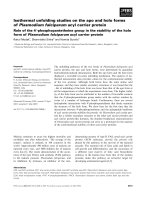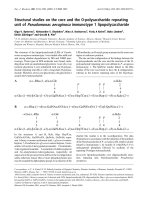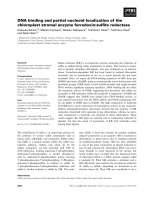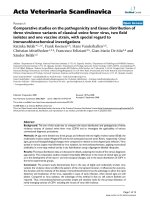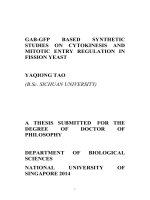Biophysical studies on DNA micromechanics and bacterial nucleoid organization
Bạn đang xem bản rút gọn của tài liệu. Xem và tải ngay bản đầy đủ của tài liệu tại đây (6.14 MB, 152 trang )
BIOPHYSICAL STUDIES ON DNA
MICROMECHANICS AND BACTERIAL NUCLEOID
ORGANIZATION
QU YUANYUAN
(B.Sc., ZJU)
A THESIS SUBMITTED
FOR THE DEGREE OF Ph.D. OF SCIENCE
DEPARTMENT OF PHYSICS
NATIONAL UNIVERSITY OF SINGAPORE
2013
i
DECLARATION
I hereby declare that this thesis is my original work and it has been written
by me in its entirety.
I have duly acknowledged all the sources of information which have been
used in the thesis.
This thesis has also not been submitted for any degree in any university
previously.
_______________
Qu Yuanyuan
13 August 2013
ii
ACKNOWLEDGEMENTS
It’s a great pleasure to take this opportunity to thank those who had helped
and supported me along the way.
Firstly and foremost, I would like to express my sincere gratitude to my
supervisor, Dr. Yan Jie, for his invaluable guidance, persistent support and
encouragement, consistent trust throughout my entire Ph.D. period. He settles a
stress-free and relaxed atmosphere in the lab that makes me four years study full
of joy and happiness.
Much thanks also goes to Dr. Fu Hongxia and Dr. Zhang Xinghua, for their
providing the corresponding single-molecule experiment data for my theoretical
studies. Especially, I am grateful to Dr. Zhang Xinghua, who not only taught me
how to do experiment when I just joined the lab, but also provided valuable
suggestions for this thesis.
I am also greatly indebted to Mr. Lim Ci Ji, for his help and advice during
our collaboration on the Lsr2 project. I am much appreciated that he generously
put in great amount of time to commend and criticize on the thesis section 1.3,
especially during his own busy period.
It is so lucky for me to be companioned with and supported by all the group
members in the lab Li You, Xu Yue, Li Yanan, Lee Sin Yi, Lim Ci Ji, Wong
Wei Juan, Yao Mingxi, Yuan Xin, Le Shimin, Chen Hu, Zhang Xinghua, Chen
Jin, Zhao Xiaodan, Cong peiwen, Saranya, Ranjit. This warm family is definitely
the biggest treasure I have dug out of my four years life in Singapore.
Last but not the least, I would like to thank my parents and my friends, for
their understanding, consideration and support during my four years study.
Especially for my boyfriend, Mr. Chen Yuchen, I am deeply appreciated for his
trust, companion, understanding and patience along the way.
iii
TABLE OF CONTENT
DECLARATION i
ACKNOWLEDGEMENTS ii
TABLE OF CONTENT iii
SUMMARY vi
LIST OF TABLES viii
LIST OF FIGURES ix
LIST OF ABBREVIATIONS xiii
CHAPTER 1 Introduction 1
1.1. Background of the study 1
1.2. Literature review on DNA micromechanics 3
1.2.1 DNA structure 3
1.2.2 DNA base pair stability 5
1.2.3 DNA conformation under force 8
1.2.4 The debate over DNA overstretching 12
1.3. Literature review on bacterial nucleoid-associated proteins (NAPs) 20
1.3.1 Introduction: NAPs in bacteria 20
1.3.2 H-NS family proteins in gram-positive bacteria 22
1.3.3 Current DNA-protein binding modes in gene-silencing mechanism . 24
1.3.4 Lsr2 protein in Mycobacterium tuberculosis 27
1.4. Single-molecule manipulation technologies and theoretical models 30
1.4.1 Introduction 30
1.4.2 Optical tweezers 30
1.4.3 Magnetic tweezers 32
1.4.4 Atomic force microscopy 34
iv
1.4.5 Effects of DNA-distorting protein on DNA force response 36
1.5. Objective of the study 39
1.6. Organization of the thesis 40
CHAPTER 2 Methods and Material 41
2.1 Single-molecule manipulation by magnetic tweezers 41
2.1.1 Instrument introduction 41
2.1.2 Force calibration of magnetic tweezers 43
2.1.3 Channel fabrication 45
2.1.4 Protocol for functionalization of coverslip 46
2.2 Atomic force microscopy imaging of DNA and DNA complex 48
2.2.1 Instrument introduction 48
2.2.2 Functionalization of glutaraldehyde modified mica surface 49
2.3 Application of transfer matrix, kinetic Monte Carlo and steered molecular
dynamics simulation in theoretical studies 51
CHAPTER 3 Theoretical studies of DNA structural transitions 56
3.1 Introduction 56
3.2 Methods 58
3.2.1 Energy analysis 58
3.2.2 Transfer matrix calculation 62
3.2.3 Kinetic Monte Carlo simulation 65
3.2.4 Steered molecular dynamics simulation 71
3.3 Results and Discussion 74
3.3.1 Phase diagram 74
3.3.2 Transfer matrix calculation of the stability of B-DNA, 2ssDNA and S-
DNA 77
3.3.3 Kinetics of DNA overstretching transitions 80
3.3.4 Insight for the structure of S-DNA 92
v
CHAPTER 4 Mechanism of DNA Organization by Mycobacterium tuberculosis Protein
Lsr2 97
4.1 Introduction 97
4.2 Material and Methods 98
4.2.1 Over-expression and purification of Lsr2 98
4.2.2 Magnetic tweezers experiments 98
4.2.3 Atomic force microscopy imaging 98
4.3 Results 100
4.3.1 Lsr2 cooperatively binds to extended DNA and stiffens DNA 100
4.3.2 The rigid Lsr2-DNA complex condenses under low force 105
4.3.3 The effects of salt, pH and temperature changes to Lsr2-DNA
organization properties 109
4.3.4 The rigid Lsr2-DNA complex is able to restrict access to DNA 113
4.4 Discussion 117
4.4.1 Structural implication of cooperative Lsr2 binding on extended DNA
117
4.4.2 Mechanism of Lsr2 mediated physical DNA organization 117
4.4.3 Implication of Lsr2 DNA-binding properties in its physiological
functions 119
CHAPTER 5 Conclusions 122
BIBLIOGRAPHY 125
LIST OF PUBLICATIONS 136
vi
SUMMARY
Deoxyribonucleic acid (DNA), the most fundamental building block of life,
is a long linear polymer that stores the genetic codes for all living organisms.
DNA is often described as the right-handed anti-parallel double helix structure,
so-called B-DNA, by Watson-Crick base-pairing interaction. However, it can
change to various structures to perform its multiple cellular functions. For
examples, melted DNA bubble forms during transcription, and the left-handed
helical Z-DNA exists in vivo, playing a role in transcriptional regulations.
Despite that many DNA structures have been identified under various
conditions, how many new structures that DNA can form is still not clear. Due to
the fundamental importance of DNA, discovering possible new DNA structures
has been one of the hot topics in biophysics research. As mechanical force is now
believed ubiquitous in cells, there has been an increasing need to understand the
micromechanics of DNA and to probe possible new DNA structures that can be
induced by force. In this regard, one of my research focuses is to understand DNA
structural transitions induced by DNA tension.
Related to my studies on DNA micromechanics, I am also interested in
addressing another important question regarding how a long genomic DNA can
be packaged into cells by proteins, and how these DNA packaging proteins affect
gene transcription. By now, the mechanism of DNA packaging in bacteria is not
well understood. The packaged genomic DNA in bacteria is called nucleoid,
which is a long circular DNA (up to a few mega bases) organized by a set of
abundant DNA binding proteins called nucleoid-associated proteins (NAPs).
Besides bacterial genome DNA packaging, these proteins also affect DNA
replication and gene transcription globally. In order to gain insights to the
mechanisms of bacterial DNA packaging and gene transcription regulation by
NAPs, I investigated the interaction between DNA and Lsr2, an important DNA
binding protein in the pathogenic bacteria Mycobacterium tuberculosis (MTB)
vii
that is believed to play a critical role in both MTB genomic DNA packaging and
controlling the pathogenesis of MTB.
Therefore, two topics, including force-induced DNA structural transitions
and the interaction between DNA and the MTB protein Lsr2, were respectively
investigated during my Ph.D. research. These studies involved extensive
theoretical and single-molecular experimental approaches, which addressed
several outstanding questions in the field.
For DNA micromechanics, I theoretically investigated the stability of
different force-induced DNA structures identified in recent experiments, and
elucidated the kinetics of their transitions from one structure to another. Further,
using a novel full-atom steered molecular dynamics simulation strategy, an
elongated double-stranded DNA structure was produced, which is a possible
candidate for the mysterious S-DNA structure.
A combination of single-DNA stretching experiment and AFM imaging was
employed to study the Lsr2-DNA interaction. I found that Lsr2 cooperatively
binds to DNA and forms a rigid Lsr2 nucleoprotein complex at a single DNA
level, which restricts DNA accessibility and also mediate tight DNA condensation.
These results provide mechanistic insights into the two functions of Lsr2,
including gene silencing by DNA access restriction, and genomic DNA packaging
by DNA condensation.
viii
LIST OF TABLES
Table 1.2.1 Unified oligonucleotide ΔH˚ and ΔS˚ NN parameters in 1 M
NaCl. 7
Table 1.2.2 Force measurements of optimal enthalpies and entropies of ten
NN base pairs in 1 M NaCl and salt dependence for individual base pair. 8
Table 1.2.3 Experimental conditions affect overstretching transition. 15
Table 1.2.4 Comparison of entropy and enthalpy changes during different
DNA overstretching transitions (13). 19
Table 3.2.1 Enthalpy and entropy values for the B-to-S transition in different
salt concentration for different DNAs. 59
ix
LIST OF FIGURES
Figure 1.1.1 Cartoon illustration of a typical bacterial structure. 2
Figure 1.2.1 DNA structure at the atomic-level. 4
Figure 1.2.2 Alternative DNA conformations. 4
Figure 1.2.3 NN model describing the DNA stability. 6
Figure 1.2.4 Force-extension behavior of ssDNA at moderate ionic strength
(black dots, 150 mM Na
+
) and low ionic strength (grey dots, 2.5 mM Na
+
). 11
Figure 1.2.5 Stretching of -DNA in 150 mM NaCl, 10 mM Tris, 1mM
EDTA, pH 8.0. 13
Figure 1.2.6 Three possible transitions to three different elongated DNA
structures. 14
Figure 1.2.7 Temperature-dependent transition force measurement indicates
two different transitions:1) B-to-ss hysteric transition associated with large
positive entropy change; 2) non-hysteretic transition associated with negative
entropy change. 16
Figure 1.2.8 Salt-dependent transition force measurement indicates two
different transitions. 17
Figure 1.2.9 Temperature dependence of transition force for three distinct
transitions 18
Figure 1.3.1 Cartoon illustration of different DNA-protein binding modes. 22
Figure 1.3.2 Solution structure of H-NS C-terminal binding domain (A) and
N-terminal oligomerization domain (B) & (C). 23
Figure 1.3.3 AFM imaging of H-NS-DNA complexes. 25
Figure 1.3.4 Two distinct gene-silencing mechanisms by two differernt H-
NS-DNA binding modes are proposed. 26
Figure 1.3.5 Lsr2 C-terminal domain shows remarkable three-dimensional
resemblance with that of H-NS protein. 28
Figure 1.3.6 AFM imaging of Lsr2-DNA complex 29
Figure 1.4.1 Sketch of general setup of optical tweezers. 31
Figure 1.4.2 Sketch of general setup of magnetic tweezers. 33
x
Figure 1.4.3 Sketch of general setup of AFM. 35
Figure 1.4.4 Effects of DNA-distorting proteins on DNA force response. 37
Figure 2.1.1 Sketch of our homemade transverse magnetic tweezers setup. 41
Figure 2.1.2 Images of homemade transverse tweezers. 42
Figure 2.1.3 Pendulum model used in force calibration of magnetic tweezers.
43
Figure 2.1.4 Illustration of homemade transverse channel. 46
Figure 2.2.1 Cartoon sketch of the AFM setup used in the lab. 48
Figure 2.2.2 Images of the AFM instrument. 49
Figure 2.3.1 Flow chart of the KMC algorithm. 52
Figure 2.3.2 Time evolution of the system by KMC method. 53
Figure 2.3.3 Simplified flow chart of MD simulation algorithm. 54
Figure 3.2.1 Two different pathways from B-DNA to ssDNA 58
Figure 3.2.2 Cartoon illustration of possible states for a nickless end-closed
DNA under force. 63
Figure 3.2.3 Theoretical models for peeling transition from dsDNA (B-DNA
or S-DNA). 66
Figure 3.2.4 Initial formation of a bubble breaks two base pairs stacking
energy and creates two boundaries i-1, i+1. 69
Figure 3.2.5 Modeling system with 15 bp DNA (alternating GC sequence) in
1 M Na
+
. 71
Figure 3.2.6 Cartoon illustration of restraint DNA construct. 73
Figure 3.3.1 Force-temperature phase diagram at 150 mM NaCl for a 50%
GC content DNA. 74
Figure 3.3.2 Energy difference per base pair between 1ssDNA under tension
and 2ssDNA under tension. 75
Figure 3.3.3 Force-salt phase diagram at 24 ˚C (A,B) or 50 ˚C (C) for a 50%
GC content DNA. 76
Figure 3.3.4 The force-extension curve of ssDNA peeled from -DNA in
different salt concentration. 78
xi
Figure 3.3.5 B-DNA, S-DNA and ssDNA fractions under different forces in 1
or 100 mM NaCl at 23 ˚C. 78
Figure 3.3.6 B-DNA, S-DNA and ssDNA fractions under 82 pN in different
salt concentration ranging from 0.5 to 100 mM NaCl at 23 ˚C. 79
Figure 3.3.7 Transition between S-DNA and two parallel ssDNA under 82
pN at 23 ˚C. 80
Figure 3.3.8 Detailed dynamics of 576 bp DNA at different forces during
overstretching transition in 150 mM NaCl at 24 ˚C. 82
Figure 3.3.9 Free energy landscape of the 576 bp DNA in 150 mM NaCl at
24 ˚C. 83
Figure 3.3.10 Detailed dynamics of 576 bp DNA at different forces during
overstretching in 1 M NaCl at 24 ˚C. 84
Figure 3.3.11 KMC simulation prediction of the dynamics of B-to-S
transition of 576 bp DNA a in 1 M NaCl at 24 ˚C. 85
Figure 3.3.12 Free energy landscape of the 8015 bp DNA under high force at
13 ˚C in different salt concentrations. 87
Figure 3.3.13 Simulation results (A) and experimental observation (B) of S-
to-ss transition occurred under 97 pN in 4 mM NaCl at 13 ˚C. 88
Figure 3.3.14 Simulation results (A) and experimental observation (B) of ss-
to-S re-annealing occurred under 97 pN or 74 pN in 200 mM NaCl at 13 ˚C.
88
Figure 3.3.15 KMC simulation for internal melting transition occurred in B-
DNA (A) and S-DNA (B). 90
Figure 3.3.16 The effects of different attempting rates and boundary energies
for internal melting transition occurred in S-DNA. 91
Figure 3.3.17 Sketch summary of the pathway of overstretching transition
and the inter-conversion between the overstretched under appropriate
environmental conditions. 92
Figure 3.3.18 Steered MD simulation of B-to-S transition. 93
Figure 3.3.19 Snapshots of the DNA structure during the transition. 93
Figure 3.3.20 16 parameters to define the base pair geometry. 94
Figure 3.3.21 Change of the twist angle between adjacent base pairs (the
middle base pairs from 6
th
bp to 10
th
bp) analyzed by 3DNA
95
xii
Figure 4.3.1 Formation of rigid Lsr2 nucleoprotein filament on extended
48,502 bp-DNA. 101
Figure 4.3.2 The bending persistence lengths A (black solid square) and the
contour lengths L (blue open circle) at different Lsr2 concentrations C of the
resulting extended Lsr2-DNA complex fitted according to the Marko-Siggia
formula (inserted formula) 102
Figure 4.3.3 The fraction of DNA occupied by Lsr2 was calculated according
to the apparent bending persistence length (see inserted formula). 104
Figure 4.3.4 Electrophoretic mobility shift assay (EMSA) of Lsr2-DNA
interaction in 10 mM Tris-HCl, 50 mM KCl, pH 7.5 buffer condition. 105
Figure 4.3.5 The rigid Lsr2-DNA complex condenses under low force. 106
Figure 4.3.6 Force-extension curves obtained by a force-decrease scan (red
solid squares) followed by a force-increase scan (red open squares) through
the same set of force values of a -DNA at 600 nM Lsr2 concentration in 10
mM Tris-HCl, 50 mM KCl, pH 7.5. 107
Figure 4.3.7 Mechanical stability of folded Lsr2-DNA complex 108
Figure 4.3.8 Effects of KCl concentration on rigid Lsr2 nucleoprotein
structure formation at 600 nM Lsr2. 110
Figure 4.3.9 Reduction of Lsr2 DNA-binding affinity in high salt (800 mM
KCl) buffer condition. 110
Figure 4.3.10 Effects of magnesium concentration on rigid Lsr2
nucleoprotein structure formation at 600 nM Lsr2. 111
Figure 4.3.11 Effects of buffer temperature on rigid Lsr2 nucleoprotein
structure formation at 600 nM Lsr2. 112
Figure 4.3.12 Effects of pH value on rigid Lsr2 nucleoprotein structure
formation at 600 nM Lsr2. 113
Figure 4.3.13 Illustration of DNase I digestion assay by magnetic tweezers
using multiplex detection algorithm. 114
Figure 4.3.14 DNase I digestion assays of DNA accessibility restriction by
rigid Lsr2-DNA complex formed on extended DNA. 115
Figure 4.3.15 Multiplex single-DNA DNase I digestion assays of rigid Lsr2-
DNA complexes. 116
Figure 4.4.1 Lsr2-DNA nucleoprotein complex formation on 19,327 bp GC-
rich DNA (GC = 57 %) and 15,003 bp AT-rich DNA (AT = 54 %). 120
xiii
LIST OF ABBREVIATIONS
DNA = deoxyribonucleic acid
dsDNA = double-stranded DNA
ssDNA = single-stranded DNA
bp = base pair
NN = nearest-neighbor
PCR = polymerase chain reaction
FJC = freely jointed chain
WLC = worm-like chain
AFM = atomic force microscopy
NAP = nucleoid-associated protein
E. coli = Escherichia coli
MTB = Mycobacterium tuberculosis
HNS = histone-like nucleoid structuring protein
HU = heat-unstable nucleoid protein
IHF = integration host factors
FIS = factor for inversion stimulation
Lrp = leucine-responsive regulatory protein
Dps = DNA-binding protein from starved cells
CbpA = curved DNA-binding protein A
xiv
StpA = suppressor of td mutant phenotype A
APTES = (3-Aminopropyl) triethoxysilane
PBS = phosphate-buffered saline
BSA = bovine serum albumin
KMC = kinetic Monte Carlo
SMD = steered molecular dynamics
MD = molecular dynamics
AMBER = Assisted Model Building and Energy Refinement
CHARMM = Chemistry at HARvard Macromolecular Mechanics
EMSA = electrophoretic mobility shift assay
1
CHAPTER 1 Introduction
1.1. Background of the study
Among the diverse biological entities, bacteria are the most abundant and
essential organisms on earth. They are present in most habitats even in acidic hot
springs and radioactive waste (1), and they are critical participators in nutrient
recycling of ecosystems.
Bacteria usually have similar components, including cell membrane,
cytoplasm, nucleoid, ribosome, flagellum and so on as illustrated in Figure 1.1.1.
The most important structure of a bacterial cell is the nucleoid, an irregularly-
shaped region which stores all or most genetic materials called chromosome (2).
The bacterial chromosome is a well-organized and highly-compacted structure
containing a piece of chromosomal DNA and many nucleoid-associated proteins
(NAPs). DNA is one of the most important and essential macromolecules for all
living organisms and even some viruses, because it encodes all the genetic
information they use to function, respond and evolve. NAPs are helpful and
crucial in DNA organization and packaging, which makes it possible to put a
millimeter’s long chromosomal DNA into the nucleoid, a volume hundreds of
times smaller than the DNA unconstrained volume. Moreover, NAPs are critical
for gene regulation, a process in which a cell decides which gene is to be
expressed and when.
As bacteria always live in a complicated and crowded environment, they
have to sense many physical aspects of external environment and internal
interactions as to respond appropriately for proper cellular functions. Force is one
such factor ubiquitous in cell growth, motion, differentiation and metabolism. For
instance, outside the bacterial cell, the interactions between a bacterial cell and
extracellular matrices or adjacent cells are usually in the presence of force; inside
2
the bacterial cell, RNA polymerases will directly exert force up to 30 pN on DNA
during the transcription process (3).
Figure 1.1.1 Cartoon illustration of a typical bacterial structure. This picture is adopted
from:
Therefore, the study regarding the force that influences on DNA structure,
property and the interaction between DNA and DNA binding proteins is
undoubtedly very important and essential, which is also the premise of our correct
and complete understanding of proper cell function and development.
3
1.2. Literature review on DNA micromechanics
1.2.1 DNA structure
DNA is the short name for deoxyribonucleic acid, a double-stranded helix
containing two long polymers running in opposite direction to each other and
winding with each other. These two long polymers consist of simple units called
nucleotides, which include four different types, namely guanine (G), adenine (A),
thymine (T) and cytosine (C). The nucleotides are composed of backbones,
phosphate groups and the nucleobases (G, A, T, C) attached to backbones. Each
type of the nucleobase on one strand can only form stable hydrogen bonds with
just one type of the nucleobase on the other strand, which means that guanine (G)
can only stably pair with cytosine (C) forming three stable hydrogen bonds, and
adenine (A) can only stably pair with thymine (T) forming two stable hydrogen
bonds. This pairing rule is called complementary base pairing, which makes the
double helix maintain a regular helical structure independent of the nucleotides
sequence. This structure of DNA was firstly solved by Francis Crick and James D.
Watson in 1953 (4), so the complementary base pair (G-C and A-T) is also called
Watson-Crick base pair. The detailed structure of DNA molecule is illustrated in
Figure 1.2.1.
Besides the B-DNA structure as shown in Figure 1.2.1, there are several
different kinds of DNA structures needed to execute multiple cellular functions,
such as single-stranded DNA (ssDNA) involved in transcription and DNA
replication (5), left-handed double-stranded Z-DNA involved in relaxing the
supercoiling stress (6), and four helices G-quadruplex structures involved in
maintaining the chromosomal stability and gene regulation (7) as illustrated in
Figure 1.2.2. Besides these known structures, recently a novel double-stranded
“S-DNA” was identified in mechanically stretched DNA at forces above ~ 65 pN
(8-15).
4
Figure 1.2.1 DNA structure at the atomic-level. This picture is adopted from:
Figure 1.2.2 Alternative DNA conformations. (A) ssDNA involved in DNA replication
and transcription. The picture is adopted from:
/>5082012045.jpg (B) Z-DNA structure. The picture is adopted from:
(C) The structure of G-quadruplex. This picture is adopted from:
5
The sequence of the nucleotides contains the genetic information that DNA
encodes. DNA is a perfect carrier for genetic information for many reasons. First,
as the backbone of the DNA is made of deoxyribose sugar, it is stable and
resistant to cleavage. Second, the complementary base pairing ensures the
accuracy of DNA replication to pass down the genetic information. Last, the
double-stranded helices structure makes it a build-in duplicate of the encoded
genetic information.
1.2.2 DNA base pair stability
As mentioned in section 1.2.1, the complementary base pairing of the
nucleotides is based on the formation of the stable hydrogen bonds, and DNA
with high GC-content is more stable than DNA with high AT-content (16).
However, on the contrary to intuitive belief, the hydrogen bonds between the
nucleotides do not notably stabilize DNA, while the stacking interaction,
including dispersion attraction, short-range exchange repulsion and electrostatic
interaction (17), between the adjacent base pairs is the main factor stabilizing
DNA (16,18). The DNA base pair stability is often described by the DNA melting
temperature (T
m
), the temperature at which half of the double-stranded DNA
(dsDNA) base pairs are unpaired in single-stranded DNA (ssDNA) state.
Typically, the T
m
of DNA is in the range of 40 – 100
o
C depending on DNA
sequence, DNA length, and salt concentration (19).
The DNA stability is mainly determined by nearest neighboring base pair
stacking, which is usually referred as the nearest-neighboring (NN) model (20).
The four different bases define 16 different sequence-dependent stacking, among
which only 10 are non-redundant ones (red, right panel in Fig. 1.2.3). Therefore,
in the NN model, the sequence-dependent base pair stacking energies are
described for the following adjacent base pair combinations: AA/TT, AT/TA,
TA/AT, CA/GT, GT/CA, GA/CT, CG/GC, GC/CG and GG/CC.
6
Figure 1.2.3 NN model describing the DNA stability. Ten non-redundant base pairs are
highlighted in red in the table.
The application of the NN model to DNA can be traced back to 1960s, a few
years after the DNA structure was revealed. Tinoco and coworkers are the
pioneers in predicting the stacking energy using NN model. Early in 1962, DeVoe
and Tinoco theoretically calculated the free energy of the nearest-neighbor base-
base interactions of DNA helix both in vacuum and in solution (16). Followed by
this, a series theoretical studies based on NN model by Tinoco et al. came out
regarding the sequence-dependent stability of DNA and RNA molecules (21-24).
A few years later, with the determination of the sequence for X174 DNA by
Sanger et al. in 1977 (25), Lyubchenko et al. made a direct comparison between
the theoretical and the experimental DNA melting profiles for the first time in
1978 (26). Subsequently, a few more papers did the comparison but failed to get a
good agreement between the theoretical prediction and the experimental
observation for different DNAs (27-32). After decades of corrections and
improvements, there are several sets of NN parameters for predicting sequence-
dependent DNA stability in the literature (19,33-40). Among those studies,
different designs of DNAs and salt conditions are chosen, different methods to
determine thermodynamics and different ways to present data are employed in
different research groups, which brought up great confusion between different
sets of NN parameters.
In 1998, SantaLucia et al. (20) summarized seven sets of the NN parameters
in the literature (19,33,34,36,38-40) and found that they were actually in quite
7
good agreement with each other. Furthermore, a single set of NN parameters
showing the entropy () and enthalpy () changes of ten NN base pairs
during the thermal melting process were provided in this paper as shown in Table
1.2.1. Therefore, the free energy of ten NN base pairs stacking under different
temperature could be obtained by following equation: .
Furthermore, the salt dependence of the free energy was also derived with an
empirical equation:
where represents the monovalent ionic (e.g., Na
+
) strength, and I
0
= 1 M,
denotes the standard ionic strength, kcal/mol is the salt-dependent
correction parameter that is the same for all NN base pairs. Since then, this set of
NN parameters has been widely used in predicting the DNA folding and
hybridization (41,42), estimating DNA melting temperature for specific DNA
design (43), probing design for array-based experiment (44) and predicting DNA
structural transition under force (45).
Table 1.2.1 Unified oligonucleotide ΔH˚ and ΔS˚ NN parameters in 1 M NaCl. Table is
adopted from SantaLucia et al. (20), where signs are reversed to denote the energy cost.
Sequence
ΔH˚
kcal/mol
ΔS˚
cal/(K•mol)
AA/TT
7.9
22.2
AT/TA
7.2
20.4
TA/AT
7.2
21.3
CA/GT
8.5
22.7
GT/CA
8.4
22.4
CT/GA
7.8
21.0
GA/CT
8.2
22.2
CG/GC
10.6
27.2
GC/CG
9.8
24.4
GG/CC
8.0
19.9
8
However, these NN parameters mentioned above are all measured based on
thermal DNA denaturation experiments. In 2010, Huguet et al. (46) obtained the
NN parameters from single-molecule stretching experiment and further improved
the salt dependent parameter m
i
for individual base pair as listed in Table 1.2.2.
This set of NN parameters provided additional information for studying DNA
conformational changes under external force or tension in different solution
conditions.
Table 1.2.2 Force measurements of optimal enthalpies and entropies of ten NN base
pairs in 1 M NaCl and salt dependence for individual base pair. This table is adopted
from Huguet et al. (46), where the sighs are reversed to denote energy cost.
Sequence
ΔH
i
kcal/mol
ΔS
i
cal/(K•mol)
m
i
kcal/mol
AA/TT
7.28
20.28
0.145
AT/TA
4.63
11.62
0.117
TA/AT
8.31
25.06
0.091
CA/GT
8.96
24.48
0.091
GT/CA
5.80
14.46
0.099
CT/GA
5.21
12.89
0.070
GA/CT
8.16
22.46
0.155
CG/GC
9.66
24.43
0.132
GC/CG
10.10
25.96
0.079
GG/CC
8.57
22.30
0.063
1.2.3 DNA conformation under force
As a well-defined long polymer with unique mechanical properties, the
conformation of DNA under force has attracted attentions from many polymer
physicists. Further, as DNA is mechanically folded in cells, the mechanical
response of DNA also has important physiological implications. Therefore, it is
necessary to investigate DNA elasticity and conformational changes under force.
9
In 1992, the first direct mechanical measurements of the elasticity of single
DNA molecule were carried out by Smith et al. (47). In this experiment, they
measured the DNA force-extension curve for the first time, which could be well
fitted by the worm-like chain (WLC) model, describing DNA as an inextensible
elastic rod with a finite bending rigidity (48,49). In the WLC model, for a given
conformation of a stretched DNA with a contour length of L, its conformational
free energy is described by:
where
is the tangent vector, is the arc length,
is the local curvature of the
DNA, is the end-to-end extension of the DNA and f is the tensile force applied
to the DNA. The parameter A, which is often referred as the bending persistence
length, describes the DNA bending rigidity. From this model, at high force
(), the force-extension curve is derived to be :
while at low force (), it is :
A direct interpolation of the two force limits leads to the Marko-Siggia formula:
which approximates the force responses of DNA over a wide force range from 0
to 20 pN. Fitting the force-extension curve measured by Smith et al. (47) with the
Marko-Siggia formula leads the bending persistence length A of DNA to be ~ 50
nm (48,49).
The Gibbs free energy per base pair at constant force can be obtained by
integration of the extension


